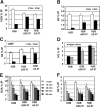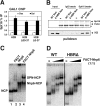A highly conserved region within H2B is important for FACT to act on nucleosomes
- PMID: 24248595
- PMCID: PMC3911510
- DOI: 10.1128/MCB.00478-13
A highly conserved region within H2B is important for FACT to act on nucleosomes
Abstract
Histone N-terminal tails play crucial roles in chromatin-related processes. The tails of histones H3 and H4 are highly conserved and well characterized, but much less is known about the functions of the tails of histones H2A and H2B and their sequences are more divergent among eukaryotes. Here we characterized the function of the only highly conserved region in the H2B tail, the H2B repression (HBR) domain. Once thought to play a role only in repression, it also has an uncharacterized function in gene activation and DNA damage responses. We report that deletion of the HBR domain impairs the eviction of nucleosomes at the promoters and open reading frames of genes. A closer examination of the HBR domain mutants revealed that they displayed phenotypes similar to those of histone chaperone complex FACT mutants, including an increase in intragenic transcription and the accumulation of free histones in cells. Biochemical characterization of recombinant nucleosomes indicates that deletion of the HBR domain impairs FACT-dependent removal of H2A-H2B from nucleosomes, suggesting that the HBR domain plays an important role in allowing FACT to disrupt dimer-DNA interactions. We have uncovered a previously unappreciated role for the HBR domain in regulating chromatin structure and have provided insight into how FACT acts on nucleosomes.
Figures






Comment in
-
FACT and the H2B N tail.Mol Cell Biol. 2014 Feb;34(3):300-2. doi: 10.1128/MCB.01519-13. Epub 2013 Nov 25. Mol Cell Biol. 2014. PMID: 24277935 Free PMC article.
Similar articles
-
FACT Disrupts Nucleosome Structure by Binding H2A-H2B with Conserved Peptide Motifs.Mol Cell. 2015 Oct 15;60(2):294-306. doi: 10.1016/j.molcel.2015.09.008. Epub 2015 Oct 8. Mol Cell. 2015. PMID: 26455391 Free PMC article.
-
Insight into the mechanism of nucleosome reorganization from histone mutants that suppress defects in the FACT histone chaperone.Genetics. 2011 Aug;188(4):835-46. doi: 10.1534/genetics.111.128769. Epub 2011 May 30. Genetics. 2011. PMID: 21625001 Free PMC article.
-
The Abundant Histone Chaperones Spt6 and FACT Collaborate to Assemble, Inspect, and Maintain Chromatin Structure in Saccharomyces cerevisiae.Genetics. 2015 Nov;201(3):1031-45. doi: 10.1534/genetics.115.180794. Epub 2015 Sep 28. Genetics. 2015. PMID: 26416482 Free PMC article.
-
The specificity of H2A.Z occupancy in the yeast genome and its relationship to transcription.Curr Genet. 2020 Oct;66(5):939-944. doi: 10.1007/s00294-020-01087-7. Epub 2020 Jun 14. Curr Genet. 2020. PMID: 32537667 Review.
-
Transcription through chromatin: understanding a complex FACT.Biochim Biophys Acta. 2004 Mar 15;1677(1-3):87-99. doi: 10.1016/j.bbaexp.2003.09.017. Biochim Biophys Acta. 2004. PMID: 15020050 Review.
Cited by
-
Regulation of chromatin structure and function: insights into the histone chaperone FACT.Cell Cycle. 2021 Mar-Mar;20(5-6):465-479. doi: 10.1080/15384101.2021.1881726. Epub 2021 Feb 16. Cell Cycle. 2021. PMID: 33590780 Free PMC article. Review.
-
Tandem Affinity Purification and Mass-Spectrometric Analysis of FACT and Associated Proteins.Methods Mol Biol. 2023;2701:209-227. doi: 10.1007/978-1-0716-3373-1_14. Methods Mol Biol. 2023. PMID: 37574485
-
Opposing Roles of FACT for Euchromatin and Heterochromatin in Yeast.Biomolecules. 2023 Feb 16;13(2):377. doi: 10.3390/biom13020377. Biomolecules. 2023. PMID: 36830746 Free PMC article. Review.
-
A basic domain in the histone H2B N-terminal tail is important for nucleosome assembly by FACT.Nucleic Acids Res. 2016 Nov 2;44(19):9142-9152. doi: 10.1093/nar/gkw588. Epub 2016 Jul 1. Nucleic Acids Res. 2016. PMID: 27369377 Free PMC article.
-
Characterization of a polyclonal antibody that is highly selective for the D-isoAsp-25 variant of mammalian histone H2B.Amino Acids. 2023 Apr;55(4):541-544. doi: 10.1007/s00726-023-03242-z. Epub 2023 Jan 30. Amino Acids. 2023. PMID: 36717395 Free PMC article.
References
Publication types
MeSH terms
Substances
Grants and funding
LinkOut - more resources
Full Text Sources
Other Literature Sources
Molecular Biology Databases
